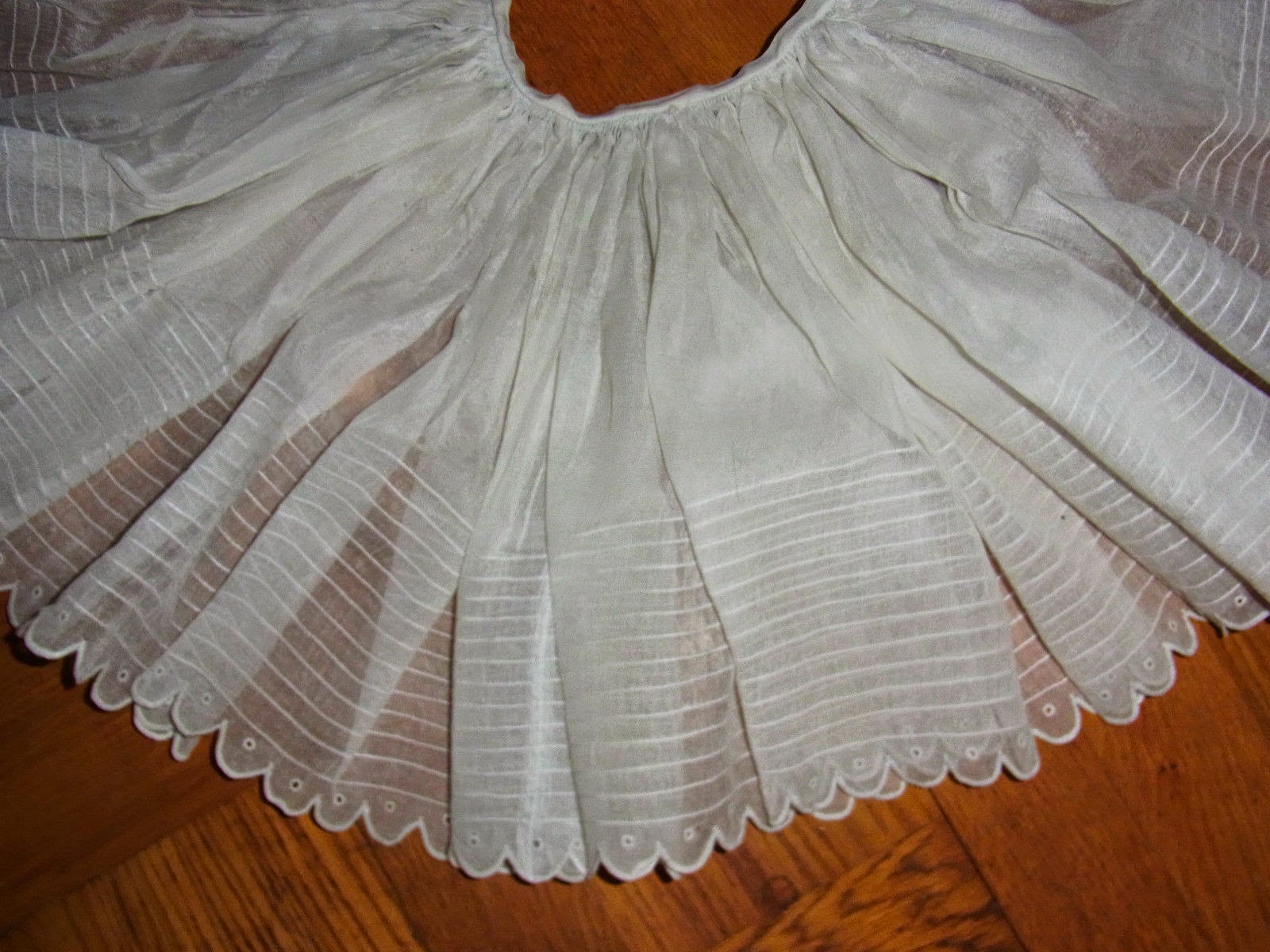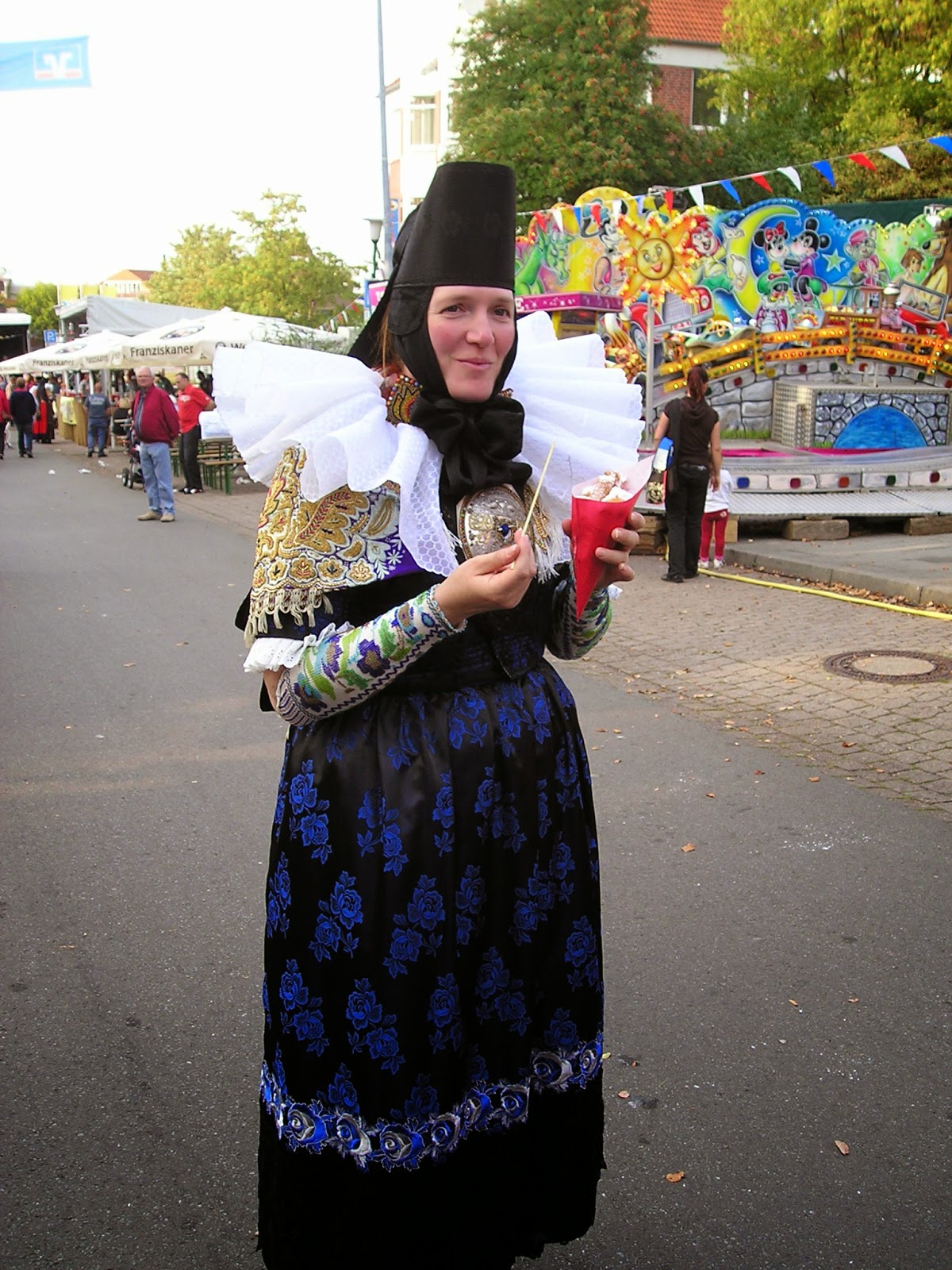Hello all,
Today I will be venturing into a country about which I have written little, Germany. There is a rich folk costume tradition in Germany, and yet there seems to be a dearth of detailed descriptive writing on the subject, which somewhat baffles me, as it would seem to be the kind of thing that the German people would thoroughly document.
Schaumburg is a relatively small region on the border of Westphalia and Lower Saxony, in northwest Germany, about 30 miles or so west of Hanover. Its history is quite complicated.
This area traditionally spoke the Lower German language, Nedderdüütsch, being on the edge of the Lower Saxon and Westphalian dialects.
http://en.wikipedia.org/wiki/Schaumburg
There are four variations of the costume of this area, which differ mainly in the woman's festive headdress. These geographic variants are the Frille Costume, the Bückeburg Costume, the Lindhorst Costume, and the Apelern Costume, this last being found today only in one town.
Frille Costume
Bückeburg Costume
Lindhorst Costume
Apelern Costume.
This is not shown on the map above, but the town of Apelern is in the southeast corner of the LIndhorst region.
On more mundane occasions when the headdress is not worn, it becomes difficult to identify which region these costumes are from. Note the topknot on the front of the head, this is the traditional hairstyle for all of these costumes, and helps to hold the festive headdress in place. These costumes are a living tradition, to the point where today there are still some older women who have never worn anything else.
I shall spend the rest of this article talking about the LIndhorst Costume, specifically the festive costume.
Besides Lindhorst itself, this costume is also worn in the communities of
Lauenhagen, Heuerssen, Probstshagen, Wendthagen, Bad-Nenndorf, Beckedorf, Hohnhorst, Rodenberg, and part of Stadthagen.
The foundation of the costume is a linen chemise, Hiemd, which today is often of cotton. Originally the large collar and the lace cuffs were part of it, but today, they are most commonly separate pieces. The sleeves come only to the elbows.
Then comes the unterkleid, the petticoat. This may have an attached bodice, but it can also be just a skirt, Unnerock. This comes in various colors, and generally has black ribbons sewn on near the hem. For everyday, this is the main garment.
If the unterkleid has a bodice, then the Kaputt is worn over it, if not, then it may be worn under it. This is a blouse or camisole with elbow length sleeves. The sleeves have a wide ribbon sewn to the hems. This ribbon matches the one on the hem of the outer skirt The kaputt buttons down the front, and resembles the one worn in Volendam in the Netherlands, but has a high neckline. There is a bodice or vest, the Bostdauk, worn over the kaputt. This has a small plastron buttoned onto the front. This garment has a wide ribbon sewn around the waist which matches the ones on the kaputt and outer skirt.
The starched lace cuffs are attached to the ends of the kaputt sleeves.
The lower arms are covered with Hanschen, which are separate sleeves knitted in various designs, usually with beads knitted into them. They come in various colors.
Then comes the famous red skirt, rock, of a heavy red wool with a wide patterned hem which matches the kaputt and bostdauk.
You can see here how the ribbons match when the costume is put on. The girl on the right is wearing the everyday outfit. You see how the regular skirt for daily wear is the same as the underskirt for more formal wear. Notice also the difference in the shoes.
For more ordinary occasions, as you can see here above, a silk apron, Schörten, with a wide black lace panel sewn over the bottom is worn, as is a knitted shawl, Dauk.
A belt, Bandeliere, is worn over those.
For more festive occasions,
both the apron and the shawl are embroidered in silk with large floral
motifs, usually in white or red on black. The shawls often have more
colors, and may incorporate some beadwork. The shawls are also edged with fringe or small tassels. A perusal of the various aprons shows a variety of compositions.
Here the design on an old apron was copied onto a new one. This is unusual, most aprons are unique in their composition.
The large ruffled lace collar, Hälschen, is starched, ironed, and then put on over the shawl.
This woman above is showing how the collar is ironed. She is in the everyday work costume with the knitted shawl.
Over this is worn a sort of tie, Halsdauk, two trapezoidal pieces with bead embroidery connected by a ribbon.
A choker of large amber beads, Krallen, is worn around the neck. The ones worn in the Lindhorst area have panels of beadwork on either side of the clasp.
The large round brooch, Spange, and the pointed black headdress, Punzmüssen, are both unique to the Lindhorst area. Large earrings, Uhrring, are also worn, they have long shafts so that they may lie on top of the headdress ties. Finger rings are also worn.
The Punzmüssen has beadwork on the crown and on the ends of the ribbons which hang in back. Wide, patterned silk ribbons are used to make this garment. It amounts to a cylinder with chin ties and a very large bow in back.

This is an american woman who bought very nice parts of the costume, but seems to have made her own Punzmüssen. Notice the satin has no pattern, and the ties under the neck are too small. Compare to the girl from LIndhorst above.
She also has her hair falling out the back. This is wrong. The hair should not be visible. To wear the headdress properly, the hair is gathered into a topknot, the Punz. Here are some ladies wearing the traditional hairstyle without the Punzmüssen. The headdress fits nicely over the Punz.
This is a contemporary photograph. These ladies are all dressed in mourning outfits.
In cooler weather, or when appropriate, a jacket may be worn. A shawl may also be worn over the head that leaves the punz uncovered. These are usually knitted.

Silk capes are worn for dressy occasions. Here you can see that the wide ribbons on the headdress form a very large bow.
Bridesmaids, Kranzmaike, and Baptismal attendants, Patinnen, wear a crown, which also fits over the punz. This is usually accompanied by a rosette of colored silk ribbons, Krallenbaend, worn on the back. This may be worn for other ceremonial occasions as well.
Brides, in addition to the the Krallenbaend and the crown with rosemary twigs attached, wear a headband under it with eight wide ribbons that hang down all around, and a sort of bibbed 'apron', Brüstchen, which also has wide ribbons that hang from the waist. The headdress ribbons are arranged so that 4 fall in back, 2 over the shoulders, and 2 in front.
Thank you for reading, I hope that you have found this interesting and informative.
I will close with a few more images of this costume.

A children's dance group from Lindhorst
https://www.youtube.com/watch?v=8WWfoVOCNnM
A group from Lindhorst marching in a parade. Not the best video, but you can see the costume.
https://www.youtube.com/watch?v=nkqTS4PiZmo
Email: rkozakand@aol.com
Source material:
Many of the individual pieces pictured i found available on German Ebay. Some may still be. You can find them here.
http://www.ebay.de/sch/i.html?_trksid=p2050601.m570.l1313.TR0.TRC0.H0.Xlindhorster+tracht&_nkw=lindhorster+tracht&_sacat=0&_from=R40
and here
http://www.ebay.de/sch/i.html?_trksid=p2050601.m570.l1313.TR0.TRC0.H0.Xschaumburger+tracht&_nkw=schaumburger+tracht&_sacat=0&_from=R40
Friederike Kaesting et al, 'Rote Roeke', Hannover, 2000
Brunhilde Miehe, 'Der Tracht Treu Geblieben bd 4', Bad Hersfeld, 2005
Josef Dunninger, 'Deutsche Volkstrachten', Berlin, 1911
Erich Retzloff-Duesseldorf, 'Deutsche Trachten', Leipzig, 1937
Uwe Karsten, 'Deutsche Trachten', Vienna, 1980
'Deutsche Volkstrachten - Ein Sammlung Deutsche Trachtenbilder', 1938
Erich Retzlaff, 'Deutsche Trachten', Munich, 1958
Debionne and Meissner, 'Die Schoensten Deutschen Trachten', Munich, 1987





















































































































beautiful costumes!
ReplyDeletethank you for writing about and posting this many great pics!
if one is interested here in Germany for old traditions such as costumes - one goes on a narrow ridge.
the folk traditions have been misused so often in our history. local traditions practiced by the local people are accepted. but a overall interest in Folk Customs in the German-speaking areas is often misunderstood.
greetings from south eastern germany (saxonia)
beate
Some source links are missing! These are
ReplyDeletehttp://www.schaumburger-tracht.de
http://www.niendaersche-kaumelkers.de
Thank you for these links
DeleteHaus kaufen Sögel If conceivable, as you clear knowledge, would you mind updating your blog with more information? It is damned helpful in return me.
ReplyDeleteGreat information related to this beautiful costume. Thank you very much!
ReplyDeleteThank you so much. My ancestors lived in this region in the early nineteenth century, and it is fun to see the way they lived. Thank you for the specific details you included.
ReplyDeleteI am argentinian and part of an asociation of german inmigrants and descendants. Every year we try to study and replicate a costume from one part of Germany. I have a cuestion, in the trachtengruppe video the girls are dancing without a headpiece. When is it worn? Is it always obligatory? Thank you in advance.
ReplyDelete